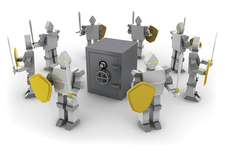Data encryption with SiriKali
Hardened Choice

SiriKali encrypts files and directories with just a few mouse clicks, without the inefficiency of fixed-size containers.
Many Linux users are wary of encrypting their data – primarily because most of the available tools don't offer a graphical user interface, and also – but less often – because of a perceived lack of flexibility in handling encrypted data files. But in the modern era, when high-capacity USB media are easy to find, encryption is becoming more important. Tools such as TrueCrypt or its successor VeraCrypt have a graphical user interface but create containers of a fixed size, without the flexibility to deal with growing volumes. If you store only a few files, you are wasting storage space with a big container. On the other hand, if you create a container that is too small, running out of space will mean a time-consuming overhaul.
SiriKali [1] is an encryption tool that avoids fixed sizes for containers. By encrypting at the directory and file level, you only use as much storage space as the data actually takes up. SiriKali relies on various encryption back ends, with support for fscrypt, SecureFS, eCryptFS, CryFS, EncFS, gocryptfs, and SSHFS. (If you're considering EncFS, keep in mind that security vulnerabilities were discovered in an audit in 2014.)
In SiriKali, you deploy encrypted filesystems in user space – with the help of the FUSE kernel module, which means that you can work with the tools without needing admin privileges. SiriKali recognizes the back ends installed in the system and lets you use them without having to enter any parameters.
[...]
Buy this article as PDF
(incl. VAT)
Buy Linux Magazine
Subscribe to our Linux Newsletters
Find Linux and Open Source Jobs
Subscribe to our ADMIN Newsletters
Support Our Work
Linux Magazine content is made possible with support from readers like you. Please consider contributing when you’ve found an article to be beneficial.

News
-
Zorin OS 18 Hits over a Million Downloads
If you doubt Linux isn't gaining popularity, you only have to look at Zorin OS's download numbers.
-
TUXEDO Computers Scraps Snapdragon X1E-Based Laptop
Due to issues with a Snapdragon CPU, TUXEDO Computers has cancelled its plans to release a laptop based on this elite hardware.
-
Debian Unleashes Debian Libre Live
Debian Libre Live keeps your machine free of proprietary software.
-
Valve Announces Pending Release of Steam Machine
Shout it to the heavens: Steam Machine, powered by Linux, is set to arrive in 2026.
-
Happy Birthday, ADMIN Magazine!
ADMIN is celebrating its 15th anniversary with issue #90.
-
Another Linux Malware Discovered
Russian hackers use Hyper-V to hide malware within Linux virtual machines.
-
TUXEDO Computers Announces a New InfinityBook
TUXEDO Computers is at it again with a new InfinityBook that will meet your professional and gaming needs.
-
SUSE Dives into the Agentic AI Pool
SUSE becomes the first open source company to adopt agentic AI with SUSE Enterprise Linux 16.
-
Linux Now Runs Most Windows Games
The latest data shows that nearly 90 percent of Windows games can be played on Linux.
-
Fedora 43 Has Finally Landed
The Fedora Linux developers have announced their latest release, Fedora 43.

